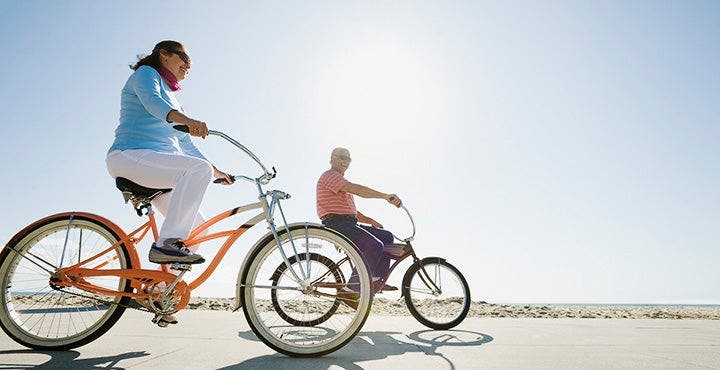Know before you go: Beach cycling


Turning up some pedal power and hopping on board a bike is one of the best ways to enjoy the sights and sounds of a day at the beach. Many local beaches offer miles of flat, paved bike paths that follow along the shoreline, so you can take in some sun and fit in some activity while those ocean breezes keep you cool!
And even if you’re nowhere near the water, you can enjoy a day in the saddle with these simple tips from Jen Audia, U.S. marketing manager for Liv Cycling—a Ventura, CA, resident who’s logged plenty of miles biking near the beach!
Before you go…
Fill up your tires. “Both tires and their inner tubes are permeable, which means they naturally lose a couple of pounds of pressure after even just a few days,” explains Audia. Check the recommended pressure (PSI) listed on the side of the tire, and then use a pump (if you don’t have one, head to the bike shop for some free air) to fill it up. If not, warns Audia, your ride may feel sluggish and you can increase the risk of getting a flat tire.
Adjust the seat. One of the biggest mistakes people make when riding a bike is keeping the seat too low. But that can hurt your knees—not to mention make your ride less efficient. As a general rule of thumb, the seat should come up to about the top of your hip bone when you’re standing to one side of it. But a better way to tell is to just get on and start pedaling—you should have a slight bend (about 30 degrees) in your knee when the pedal is at the bottom-most point in the cycle, or the 6 o’clock position. Concerned your feet won’t touch the ground? If you come to a complete stop, you should slide forward off your seat so that your feet are flat on the ground to maintain a safe and stable position.
Bring…
Sun protection. It’s important to keep your skin safe by applying sunscreen whenever you’re outside in the daylight. Even on cloudy days, about 70 to 80 percent of UV rays can penetrate and damage the skin, according to the Skin Cancer Foundation. Wearing sunglasses can also help protect your eyes from glare as well as swirling sand or other debris churned up by the wind.
Water. Spending time under the sun can quickly make you dehydrated, especially on warm days or if you’re sweating a lot. Most bikes have a built-in cage to hold a water bottle. Keep your bottle cool by filling it with ice before you leave.
Lock. If you want to stop for lunch, a drink, or just to dip your feet in the water, locking up your bike will give you peace of mind when you’re not able to keep an eye on it. A simple cable lock should suffice for most situations, but if you want something a little sturdier you can also carry a U-lock (named for its horseshoe shape) or a thicker chain lock.
Expect to…
Ride tall. The most comfortable bikes for riding casually are called cruisers, which generally feature a wide, cushioned seat, a lower top tube that makes it easy to get on and off, and wider tires that can take on both pavement and grittier terrain. You’ll mostly sit up on these bikes (not lean forward as with a road bike) and use upright handlebars.
Wear comfortable shoes and a helmet. Just because you’re near the beach doesn’t mean you should keep the flip-flops on. Having a shoe or a sandal with a strap can make it a lot easier to pedal, especially if you need to climb any hills on your way to or from the bike path.
Just because you are on a beach path, doesn’t mean you shouldn’t wear a helmet. “Helmets should always be worn when riding your bike,” Audia says. “Make sure it is fit properly to your head so that most of your forehead is covered, not tilted back so it starts at your hairline.”
Take a stretch when you’re done. Cruising along the beach may not feel too terribly taxing, but it can help to stretch out your muscles when your ride is over, says Audia. Top tight spots typically include your lower back, quads, and calves.
RELATED: Ready, set...cycle
